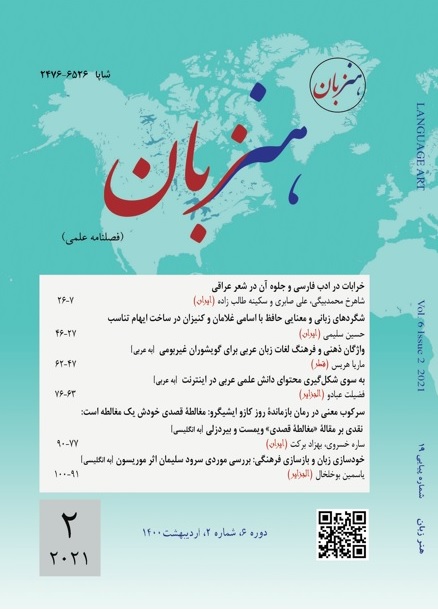سرکوب معنی در رمان بازماندۀ روز کازو ایشیگرو: مغالطۀ قصدی خودش یک مغالطه است: نقدی بر مقالۀ «مغالطۀ قصدی» ویمست و بیردزلی
DOI::
https://doi.org/10.22046/LA.2021.11کلمات کلیدی:
مغالطۀ قصدی , قصد نویسنده, نقد نو, معنای زبانی, زبانچکیده
این تحقیق در تلاش است تا اشتباهات مقالۀ «مغالطۀ قصدی» از ویمست و بیردزلی را بررسی کند. این دو منتقد نقد نویی بر این باورند که قصد نویسنده نباید هنگام ارزیابی متن در نظر گرفته شود، چون قصد نویسنده نه موجود است و نه مطلوب. این تحقیق دو مورد از ادعاهای این دو تن را زیر سؤال میبرد: اول اینکه قصد نویسنده مجزا از معنای متنی است و دوم اینکه قصد نویسنده عاملی شخصی و بیوگرافیکی است در حالی که شعر عمومی است. این مقاله برای رد کردن ادعای آنها از مفهوم معنای زبانی ای. دی هیرش استفاده میکند. معنای زبانی نوعی از شی قصدی است که هیرش آن را هم معنی با معنای متنی میداند. این مطالعه از گفتههای هیرش فراتر میرود و ادعا میکند که از لحظهای که نویسنده قصدش را از طریق زبان به متن متنقل میکند، دیگر با قصد مواجه نیستیم بلکه با شی مواجهیم. زبان طبق نظر منتقدان نقد نو ابزاری مناسب و قابل اعتماد است، بنابراین وقتی ویمست و بیردزلی قصد نویسنده را زیر سوال میبرند، در واقع مفهوم زبان را زیر سوال میبرند. دومین ادعای آنها یعنی ماهیت شخصی قصد نویسنده با استفاده از عقیدۀ تی.اس الیوت در مورد مقایسۀ شاعر و کاتالیزگر رد میشود. الیوت معتقد است که شاعر خصوصیات شخصیتی خود را وارد شعر نمیکند. این مطالعه بینش ما را نسبت به قصد نویسنده تغییر میدهد و به ما کمک میکند تا دریابیم که قصد نویسنده نه تنها عاملی شخصی و بیوگرافیکی نیست بلکه عاملی از عوامل زبانی است.
مراجع
Abrams, M.H. (1999). The Glossary of Literary Terms. Boston: Heine & Heine.
Brooks, C. (1951). The Formalist Critics. The Kenyon Review. 13(1). 72-81
Ransom, J. C. (1937). Criticism, Inc. The Virginia Quarterly Review, 13(4), 586-602.
Cuddon, J. A. (2012). A dictionary of literary terms and literary theory. John Wiley & Sons.
Eliot, T. S. (1920). Hamlet and his problems. The sacred wood: Essays on poetry and criticism, 4, 95-104.
Eliot, T.S. (1921). Tradition and the Individual Talent. Sacred Wood. London: Methuen.42-53
Frye, N., Baker, S. W., Perkins, G. B., & Perkins, B. M. (1977). The Harper Handbook to Literature. London: Pearson.
Heidegger, Martin.(1950). Language. The Norton Anthology of Theory and Criticism. Eds. William. E. Cain. New York: Norton & Company. 1121-1134
Hirsch, E. D. (1960). Objective interpretation. PMLA, 75(4-Part1), 463-479.
Holman, C. H. (1980). A Handbook of Literature. Indiana: Bobbs-Merrill Education Pub.
Knapp, S., & Michaels, W. B. (1982). Against theory. Critical Inquiry, 8(4), 723-742.
Lyas, C. (1972). Personal qualities and the intentional fallacy. Royal Institute of Philosophy Supplements, 6, 194-210.
Pope, Alexander (1711). An Essay On Criticism. London: W. Lewis.
Richards, I. A. (1929). Practical Criticism: a study of literary judgment (London, Kegan Paul). Trench, Trubner.
Taine, Hippolyte, Adolphe. (1871). History of English literature. New York: Holt & Williams.
Wimsatt, W. K., & Beardsley, M. C. (1946). The intentional fallacy. The sewanee review, 54(3), 468-488.
Zhang, L. (2012). “The Intentional Fallacy” Reconsidered. Canadian Social Science. 8(2) April 30. 34-39. DOI: http://dx.doi.org/10.3968/j.css.1923669720120802.1045
##submission.downloads##
چاپ شده
ارجاع به مقاله
شماره
نوع مقاله
مجوز
حق نشر 2021 sareh khosravi, Dr. Behzad Barekat

این پروژه تحت مجوز بین المللی Creative Commons Attribution 4.0 می باشد.
فصلنامه هنر زبان یک مجله دسترسی آزاد است و مقالات پس از پذیرش در دسترس عموم قرار می گیرند و استفاده از آن با ذکر منبع آزاد است
